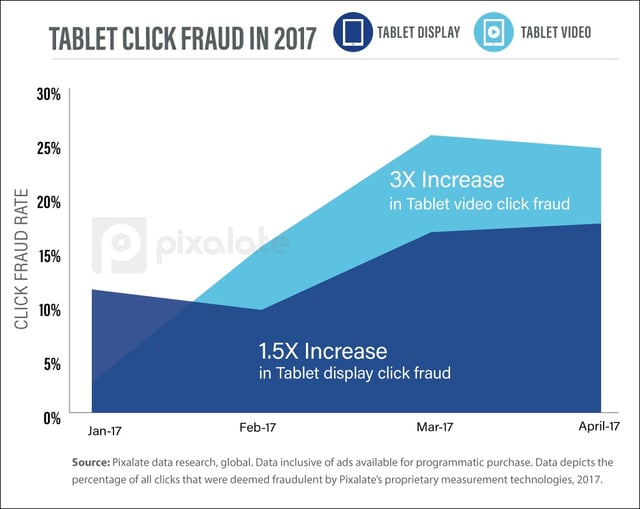
After researching desktop programmatic click fraud rates, followed by smartphone click fraud rates, we're continuing our series today with a look at tablet click fraud rates across display and video inventory, for both web and in-app ads. Just how impactful is programmatic click fraud on tablets? And what trends emerged over the first few months of 2017?
Tablet display click fraud increased by over 50% during the first four months of 2017. This data is inclusive of both web and app inventory.

We saw nearly identical trends for video click fraud on smartphones during the same time period (smartphones had an increase of 198%).
However, compared to smartphone display click fraud — which saw a rise of 11.3% from January through April — the challenge of display click fraud became a larger issue on tablets.

The rising issue of click fraud on mobile devices is not simply a smartphone- or tablet-only concern. Fraudsters are spoofing clicks across both devices — and the trends are similar.
For display advertising, click fraud does seem to be ramping up at a faster pace on tablets compared to smartphones. Display click fraud increased over 50% on tablets within the first four months of 2017.
For video advertising, click fraud had equal challenges on both smartphones and tablets. It became nearly a 3x larger issue on both devices to begin the year.
As noted before, marketers who focus campaigns on PPC and CPC opportunities in mobile need to structure those campaigns around click fraud, because our data indicates that the risk associated with these campaigns is both volatile and growing.
To see what you're up against — and to see what a mobile "click farm" looks like in action — check out this video shared by Daily Mail.
*By entering your email address and clicking Subscribe, you are agreeing to our Terms of Use and Privacy Policy.
These Stories on Mobile
*By entering your email address and clicking Subscribe, you are agreeing to our Terms of Use and Privacy Policy.

Disclaimer: The content of this page reflects Pixalate’s opinions with respect to the factors that Pixalate believes can be useful to the digital media industry. Any proprietary data shared is grounded in Pixalate’s proprietary technology and analytics, which Pixalate is continuously evaluating and updating. Any references to outside sources should not be construed as endorsements. Pixalate’s opinions are just that - opinion, not facts or guarantees.
Per the MRC, “'Fraud' is not intended to represent fraud as defined in various laws, statutes and ordinances or as conventionally used in U.S. Court or other legal proceedings, but rather a custom definition strictly for advertising measurement purposes. Also per the MRC, “‘Invalid Traffic’ is defined generally as traffic that does not meet certain ad serving quality or completeness criteria, or otherwise does not represent legitimate ad traffic that should be included in measurement counts. Among the reasons why ad traffic may be deemed invalid is it is a result of non-human traffic (spiders, bots, etc.), or activity designed to produce fraudulent traffic.”

